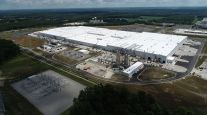GM Says Strike Cost $1.1 Billion, but Raises Dividend

[Stay on top of transportation news: Get TTNews in your inbox.]
DETROIT — General Motors says pretax earnings took a $1.1 billion hit this year due to production lost during a six-week strike by autoworkers, but the company expects to absorb the costs of a new contract and is even raising its dividend.
The Detroit automaker on Nov. 29 reinstated its full-year earnings forecast that was withdrawn after the United Auto Workers began targeting the factories of Detroit automakers with strikes on Sept. 15. Those strikes continued at GM until Oct. 30.
The company now predicts full-year net income of $9.1 billion to $9.7 billion, down from its previous outlook of $9.3 billion to $10.7 billion. But GM expects to generate more cash for the full year. It expects free cash flow of $10.5 billion to $11.5 billion, an increase from a previous forecast of $7 billion to $9 billion.
To get there, GM expects to cut capital spending, including a slowdown in spending on electric vehicles and at Cruise, its troubled autonomous vehicle unit. California regulators revoked the San Francisco-based subsidiary’s robotaxi license last month after one of its vehicles dragged a pedestrian to the side of a street after the person was hit by another car.
CEO Mary Barra wrote that GM expects the pace of Cruise’s expansion to cities outside of San Francisco to be more deliberate when driverless taxi operations resume “resulting in substantially lower spending in 2024 than in 2023.”
GM had big plans for Cruise, which it bought eight years ago. The Detroit automaker had been expecting annual revenue of $1 billion from Cruise by 2025 — a big jump from the $106 million last year. During the first nine months of this year Cruise posted pretax losses of $1.9 billion.
GM says it will raise its dividend 33% to 12 cents per share starting in January. It’s also planning to buy back $10 billion of its shares.
Shares of GM rose 8.6% before the opening bell, but remain down about 27% in the past year.
Rishi Mehra of Trimble sheds light on the immense support that transportation technology can provide to enhance the efficiency of the physical supply chain. Tune in above or by going to RoadSigns.ttnews.com.
The company said new contracts with the UAW and Canadian autoworkers will cost $9.3 billion during the next four years and eight months, with $200 million more coming this year and $1.5 billion next year. The deals will increase costs per vehicle by $500 in 2024, but analysts say competition will limit automakers’ ability to increase prices.
“We are finalizing a 2024 budget that will fully offset the incremental costs of our new labor agreements, and the long-term plan we are executing includes reducing the capital intensity of the business, developing products even more efficiently and further reducing our fixed and variable costs,” Barra said in a prepared statement.
GM, as well as rivals Ford and Jeep maker Stellantis, agreed to new contracts with the UAW that raise top assembly plant worker pay by about 33% by the time the deals expire in April of 2028. The new contracts also ended some lower tiers of wages, gave raises to temporary workers and shortened the time it takes for full-time workers to get to the top of the pay scale.
At the end of the contract top-scale assembly workers will make about $42 per hour, plus they’ll get annual profit-sharing checks.
UAW President Shawn Fain said during the contract talks that labor costs are only 4% to 5% of a vehicle’s costs, and that the companies were making billions and could afford to pay workers more.
Barra, who will update shareholders on company finances Nov. 29, conceded in a letter to investors that she’s disappointed in the pace of electric vehicle production, which she attributed to difficulties in assembling batteries.
But she wrote that GM has made improvements in the organization responsible for the work, and the company expects higher EV production and improved profit margins next year.
“While the rate of growth for EVs is slowing in the near term, it is projected to accelerate and grow substantially in the long term as customers have more EV choices, and the public charging network expands,” Barra wrote.
Want more news? Listen to today's daily briefing above or go here for more info
Earlier in the year GM delayed electric pickup truck production at a factory north of Detroit until 2025 as the growth rate in electric vehicle sales slowed.
In June of last year, electric vehicle sales were growing about 90% year-over-year, according to Motorintelligence.com. But by June of this year, the growth rate had slowed to about 50%, and automakers are fearful it will slow even further with consumers having reservations about how far they can travel and whether charging stations will be available.
Barra wrote that GM has a strong cash balance due to record profits from selling gas-powered vehicles and more efficient internal combustion and electric vehicle operations.
“We have a clear path forward that includes greater operating and investment efficiency,” she wrote.





